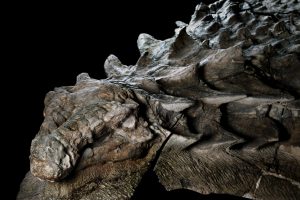 The armored dinosaur fossil, preserved in exquisite detail and unearthed in a western Canadian oil sand mine, highlights the new daunting challenges facing the theory of evolution.
The armored dinosaur fossil, preserved in exquisite detail and unearthed in a western Canadian oil sand mine, highlights the new daunting challenges facing the theory of evolution.
This stunningly preserved fossil is shattering long-standing paradigms. “The more I look at it,” said Michael Greshko, science writer for National Geographic, “the more mind-boggling it becomes.”
Caleb Brown (picture-right), a paleobiologist at the Royal Tyrrell Museum, where the fossil was placed on exhibit in August, explained to Greshko,
“We don’t just have a skeleton… We have a dinosaur as it would have been.”
 The museum hosts one of the world’s largest dinosaur collections. Now the fossil, known as Borealopelta markmitchelli (pictured), has the evolution industry struggling to place a new species in the mythical world of biological evolution, not what they once said it should be.
The museum hosts one of the world’s largest dinosaur collections. Now the fossil, known as Borealopelta markmitchelli (pictured), has the evolution industry struggling to place a new species in the mythical world of biological evolution, not what they once said it should be.
Fort McMurray
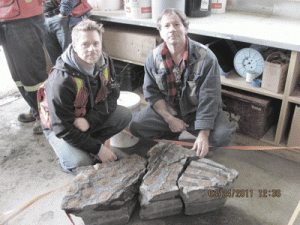 Oil sand heavy equipment operator Shawn Funk (pictured left), early in the afternoon of March 2011, was shoveling his way through the oil sands mines in Alberta, Canada, operated by Suncor. Now recognized as one of the largest petroleum reserves in the world, the area emerged as a massive final resting place for the remnants of ancient marine plants and creatures that were overwhelmed during the Earth’s global flood.
Oil sand heavy equipment operator Shawn Funk (pictured left), early in the afternoon of March 2011, was shoveling his way through the oil sands mines in Alberta, Canada, operated by Suncor. Now recognized as one of the largest petroleum reserves in the world, the area emerged as a massive final resting place for the remnants of ancient marine plants and creatures that were overwhelmed during the Earth’s global flood.
After spotting a glimpse of an unexpected lump in his shovel-load of material, Funk immediately shut down his enormous workhorse. Together with his supervisor, Michel Gratton, they immediately sent photos of their findings to the Royal Tyrrell Museum in Drumheller, Alberta. The excitement captivated Suncor. 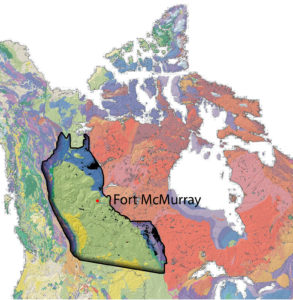
Nestled within the vast 540,000 square miles of the Western Canadian Sedimentary Basin in the province of Alberta, Suncor’s oil sand mine is near Fort McMurray. Surrounded by boreal forests at the confluence of the Athabasca River and Clear Water River, the area sits at an elevation of 1,000 feet. In this area northeast of Calgary, Donald Henderson, the museum curator, said
“We’ve never found a dinosaur in this location.”
Fascinated with the photos, the museum sent a team to investigate. Two days later, expecting to find fossilized bones of a marine reptile, the museum team quickly realized something extraordinarily unexpected had been uncovered: a non-marine monster – a dinosaur, of some sort.
“All the mine staff from every level and department,” Henderson reported in The Guardian, “were tripping over themselves offering help.” After receiving three days of intensive training, the newly formed Suncor extraction team began the tedious process of liberating fossil rock.
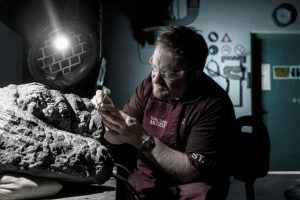 After a nearly disastrous two weeks of dust and diesel exhaust, the team successfully extracted a 15,000-pound rock containing the mega-fossil. Working in 12-hour shifts, the endeavor was caught on camera. Plaster-wrapped and hoisted onto a truck bed, the treasure-laden rock was finally sent on its 420-mile museum-bound journey to Alberta.
After a nearly disastrous two weeks of dust and diesel exhaust, the team successfully extracted a 15,000-pound rock containing the mega-fossil. Working in 12-hour shifts, the endeavor was caught on camera. Plaster-wrapped and hoisted onto a truck bed, the treasure-laden rock was finally sent on its 420-mile museum-bound journey to Alberta.
Paleontologist Mark Mitchell (pictured left) at the museum was entrusted with the project of stripping away the hard-set sediments from the fossil. Extricating the skull alone took nearly eight months. In total, after more than 7,000 hours of chipping away over almost six years, the 18-foot-long dinosaur fossil weighing nearly 3,000 pounds was finally ready to be opened to the public.
Bottom of the Sea
Dubbed the “four-legged tank” with two 20-inch long spikes protruding from the shoulders, the “body was submerged at the bottom of the sea,” explained Daniel Uria, writing for UPI news. How a terrestrial monster could have ended up at the bottom of the sea quickly emerged as an issue.
“Finding the remains of an armored dinosaur that was washed far out to sea was a huge surprise,” said Henderson in an interview with Blake de Pastino, writing for Western Digs. Science writer Ed Yong, writing for The Atlantic, speculated –
“Somehow, this particular individual ended up at sea. Perhaps it got careless on a shoreline. Perhaps it drowned in a flood and was washed out to sea.”
 Struggling with the issue, Greshko (pictured left) advanced essentially the same theory –
Struggling with the issue, Greshko (pictured left) advanced essentially the same theory –
“This armored plant-eater lumbered through what is now western Canada until a flooded river swept it into the open sea.”
After speaking with the museum paleontologists, Cecile Borkhataria and Tim Collins, writing for Britain’s popular Daily Mail, reiterated the now unavoidable flood theory –
“The researchers believe that the dinosaur lumbered through what is now western Canada until a flooded river swept it into the open sea.”
The Deer River Valley oil sands, however, are located on the eastern slopes of the Canadian Rockies. That’s a problem. In the absence of a massive global flood event, since the oil sands are far from any large body of water, the theory does not explain how a terrestrial dinosaur could have somehow ended up in an unknown, long-gone sea.
The pristine fossil record evidence from Borealopelta markmitchelli, rather than supporting Darwin’s theory of “slight, successive” incremental changes over long periods of time, suggests a near-instantaneous massive global flood phenomenon. Evolution is not what they once said it should be.
Like A Statue
 “It’s an animal so well preserved that its skeleton can’t be seen for the skin and soft tissues that still cover it,” explains science writer Ed Yong (pictured left), writing for The Atlantic, in the article entitled “A dinosaur so well preserved, it looks like a statue.”
“It’s an animal so well preserved that its skeleton can’t be seen for the skin and soft tissues that still cover it,” explains science writer Ed Yong (pictured left), writing for The Atlantic, in the article entitled “A dinosaur so well preserved, it looks like a statue.”
CNN writer Matt Rehbein’s article “Shocking lifelike dinosaur fossil makes public debut” agrees with Yong.
“The sleeping giant you see when you look at it is astounding. For one thing, you don’t see bones; most of the skeleton is undetectable because it’s covered in fossilized skin and, as the museum describes it, ‘encased in intact body armor.’”
Fossilization of the armored dinosaur happened quickly, not over a long period of time. According to Yong –
“The dead dinosaur sank and hit the ocean floor hard enough to leave a small crater. Before sharks had a chance to nibble it, or worms had a chance to burrow into its bones, it was quickly smothered by fine sediment and sealed off from the outside world.”
“Normally, when we find dinosaur fossils, we just have a skeleton, the bones. And we have to use our imaginations to reconstruct what they look like,” explained Caleb Brown in an interview with The Guardian, a British publication. Brown continued,
“In this case, we’re fortunate in that it’s not just the bones; we have all of the armour, the osteoderm is preserved, we also have all the skin preserved, and it is in three dimensions.”
Contrary to the evolution industry’s once popular foundational theory of uniformitarianism, fossils do not develop over long periods of time, as illustrated by Canada’s Red Deer River armored dinosaur. Darwin was wrong about fossilization. Evolution, not what they said it should be.
Exquisite Coloration
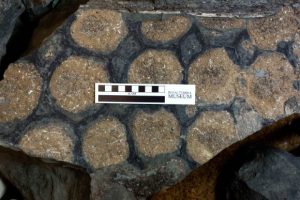 The official scientific report describing the fossil was finally published this year in the journal Current Biology, entitled,
The official scientific report describing the fossil was finally published this year in the journal Current Biology, entitled,
“An Exceptionally Preserved Three-Dimensional Armored Dinosaur Reveals Insights into Coloration and Cretaceous Predator-Prey Dynamics.”
Not only was the dinosaur fossil covered with skin (pictured left), but the preserved soft tissues were found even to have fragile biomolecular proteins exquisitely preserved – stunning for a dinosaur a million years old.
Until the discovery of the Red Deer River dinosaur, coloration in dinosaurs had been “one of the mysteries surrounding the dinosaur.” Caleb Brown, the leading author of the report published this August, focused on the coloration of the dinosaur. As Brown explains –
“Here we describe a new, exquisitely three-dimensionally preserved… Borealopelta markmitchelli…. [in] which… We identify melanin [a biomolecular protein] in the organic residues through mass spectroscopic analyses.”
Jakob Vinther (pictured left), an expert paleobiologist on  coloration from the University of Bristol, has studied the world’s best fossils for signs of skin biomolecules, such as pigments. After four days of delicately scraping, even he was astounded. The dinosaur is so well preserved that it “might have been walking around a couple of weeks ago,” Vinther explained in an interview with Gresko.
coloration from the University of Bristol, has studied the world’s best fossils for signs of skin biomolecules, such as pigments. After four days of delicately scraping, even he was astounded. The dinosaur is so well preserved that it “might have been walking around a couple of weeks ago,” Vinther explained in an interview with Gresko.
“I’ve never seen anything like this.”
The focus on coloration, however, side-steps the bigger questions posed by the fossil, including the issues of location and age. Vertebrate paleontologist Victoria Arbour at the Royal Ontario Museum, in an interview with Greshko, noted
“There’s still a lot of healthy scientific skepticism around the interpretation of ancient biomolecules like pigments.”
Victoria’s skepticism stems from one primary reason: the preservation of fragile proteins for millions of years raises questions about the validity of the evolution industry’s fossil dating techniques, as there is no scientific evidence to support the preservation of proteins for such a long period. Evolution, not what they once said it should be.
Natural Selection Problem
Borealopelta markmitchelli is a new species, neither a transitional link nor a known transitional link. That’s a big problem for the theory of evolution. Writing for National Geographic, Greshko summarized the species’ status in the title of the article.
“It’s Official: Stunning Fossil Is a New Dinosaur Species.”
Canada’s new fossil only compounds the industry’s persistent dilemma – no transitional links. Amazingly, the problem is not new to the evolution industry. Even Charles Darwin recognized the problem in The Origin of Species –
“Their [species] not being blended together by innumerable transitional links is a pronounced difficulty.”
Transitional links were nowhere to be found in the Red Deer River Valley – just unlinked species. Darwin had envisioned natural selection acting to develop new species through “innumerable transitional links,” with each link representing his “slight, successive changes.”
Natural selection theory hinges on eventually finding “innumerable” transitional links. Notably, Darwin included a method to falsify this theory of natural selection –
“If it could be demonstrated that any complex organ exists which could not possibly have been formed by numerous, successive, slight modifications, my theory would absolutely break down.”
The glaring absence of transitional links is a blatant problem for Darwin’s theory of natural selection. Critics of Darwin’s theory are not hard to find. Suncor’s armored dinosaur discovery illustrates what Curator Emeritus at the American Museum of Natural History, Niles Eldridge, confided in 1995 –
“No wonder paleontologists shied away from evolution for so long. It never seemed to happen.”
 No transitional links – no evolution. Niles’ colleague at Columbia University, Stephen Jay Gould (pictured right), who was awarded the Darwin-Wallace Medal in 2009, also emerged as one of the earliest evolution-insider critics –
No transitional links – no evolution. Niles’ colleague at Columbia University, Stephen Jay Gould (pictured right), who was awarded the Darwin-Wallace Medal in 2009, also emerged as one of the earliest evolution-insider critics –
“The absence of fossil evidence for intermediary stages between major transitions in organic design, indeed our ability even in our imagination, to construct functional intermediates, in many cases, has been a persistent and nagging problem for the gradualistic account of evolution.”
What the evolution industry desperately needs is evidence for transitions between species – certainly not more unlinked new species. New species with no known transitional links only compound the agony of a dying theory.
Using Darwin’s own criteria, the theory of natural selection has been falsified once again, this time by Canada’s newest armored dinosaur fossil.
Evolution, not what they once said it should be.
Genesis
This lone Red Deer Valley dinosaur points to the global flood Moses recorded in the Genesis account by not only falsifying evolution’s uniformitarian and millions-of-years theory, but also decimating Darwin’s theory of natural selection.
Canada’s armored dinosaur should be studied in detail in schools and colleges. Evolution is not what they once said it was. Any guarantee of developing a cohesive theory of evolution has vaporized in a chaos of contradictions.
During the early twenty-first century, scientific advances have been progressively more brutal on the theory of evolution. A.N. Wilson, in his new book just released, entitled “Charles Darwin, Victorian Mythmaker,” sides with the evolution critic movement –
“I soon came to realize, when I started my reading, that in fact there is no consensus among scientists about the theory of evolution.”
Albert Einstein, in an October 26, 1929, interview with the Saturday Evening Post, said during the Scientific Revolution –
“As a child I received instruction both in the Bible and in  the Talmud, I am a Jew, but I am enthralled by the luminous figure of the Nazarene. No one can read the Gospels without feeling the actual presence of Jesus. His personality pulsates in every word. No myth is filled with such life.”
the Talmud, I am a Jew, but I am enthralled by the luminous figure of the Nazarene. No one can read the Gospels without feeling the actual presence of Jesus. His personality pulsates in every word. No myth is filled with such life.”
Evidence for common ancestry and transitional links from the fossil record, which would validate the theory of evolution scientifically, remains speculative.
Evolution, Not What They Once Said is a Fossil Record article.
Darwin Then and Now is an educational resource on the intersection of evolution and science, highlighting the ongoing challenges to the theory of evolution.
Move On
Explore how to understand twenty-first-century concepts of evolution further using the following links –
-
- The Understanding Evolution category showcases how varying historical study approaches to evolution have led to varying conclusions. Subcategories include –
- Studying Evolution explains how key evolution terms and concepts have changed since the 1958 publication of The Origin of Species.
- What is Science explains Charles Darwin’s approach to science and how modern science approaches can be applied for different investigative purposes.
- Evolution and Science feature study articles on how scientific evidence influences the current understanding of evolution.
- Theory and Consensus feature articles on the historical timelines of the theory and Natural Selection.
- The Biography of Charles Darwin category showcases relevant aspects of his life.
- The Glossary defines terms used in studying the theory of biological evolution.
- The Understanding Evolution category showcases how varying historical study approaches to evolution have led to varying conclusions. Subcategories include –


